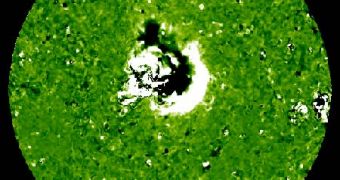Solar tsunamis were first discovered by ESA's Solar and Heliospheric Observatory during the late 1990s, when the spacecraft was launched. Solar tsunamis are in fact solar filaments which sweep across the surface of the Sun in a tsunami-like fashion, releasing great quantities of energy in very short periods of time. They come at irregular time intervals and are able to cover the whole surface of the Sun in just a few minutes.
One such solar tsunami was detected on 19 May 2007 with the help of NASA's STEREO spacecraft. It blasted all the way through the lower layers of the Sun's atmosphere, then moved through all the four layers of the solar atmosphere. The detailed analysis of the phenomenon accompanied by video images and photographs have just been released yesterday by the researching team.
Association with coronal mass ejection
On Earth, tsunamis use water as a medium to propagate through, while on the Sun, extremely hot gases are used. Even today there is little known about how tsunamis occur and behave here on Earth. To make matters worse, SOHO observations reveal that predictions don't quite match measurements.
"They seemed to be going very slowly for the amount of energy we saw in the explosion," said leader of the study, Peter Gallagher from the Trinity College Dublin. The energy released during a single such tsunami is equivalent to about two billion times that consumed on the Earth in a mere second.
Because the STEREO spacecraft is able to snap more images than SOHO, Gallagher was able to calculate that the speed at which the tsunami was moving across the atmosphere of the Sun was exceeding 1 million kilometers per hour. "They're actually traveling a lot faster than we previously thought. The speeds are astronomical, literally. These things [take] blinks of an eye to traverse the Earth," he said.
Measurements made with the Extreme Ultraviolet Imager instrument, on-board the STEREO spacecraft, revealed that the temperatures experienced by the solar material ranged between 60,000 and 2 million degrees Celsius. Furthermore, the speed of travel was not affected by material density.
The mystery remains
It is yet unclear what could cause such massive releases of energy, however scientists know that they are somehow connected with the coronal mass ejections, which harness the power of the Sun's magnetic field in order to accelerate gas into a rope-like structure far away from the surface of the Sun. Solar tsunamis could either be a coronal mass ejection Shockwave or a phenomenon related to it, nonetheless the phenomenons are associated with each other.
"When a solar tsunami goes off, it tells you that there's been an explosion of the Sun," said Gallagher.
Solar tsunamis may prove extremely important to predicting when coronal mass ejections take place, as CME could launch massive amounts of dangerous material towards Earth, but further study is needed before anyone can say what really causes solar tsunamis.

 14 DAY TRIAL //
14 DAY TRIAL //